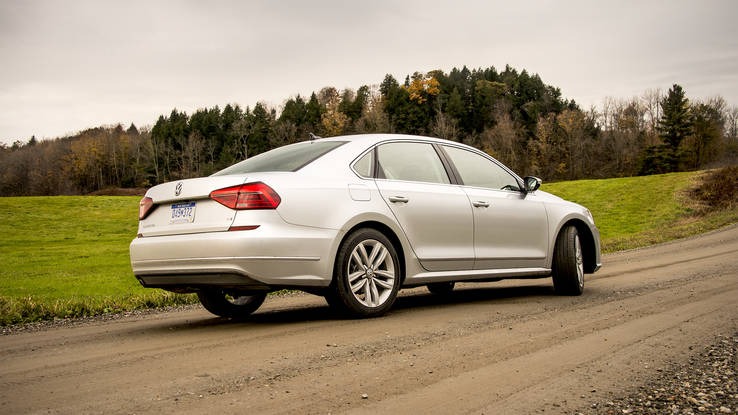Sharper bodywork and a more entertaining cabin for Wolfsburg’s midsize sedan
What is it?
The 2016 Passat marks a midcycle refresh for the Chattanooga-built sedan, one that brings an ever-so-slightly resculpted exterior and an equipment update to Wolfsburg’s midsize model. Don’t expect dramatically different bodywork — the styling is still very conservative, and the changes are far more evolutionary than the wild facelifts that the Passat’s Japanese and Korean competitors have been known to unveil.
Just two engines are on the menu for the 2016 Passat: a 1.8-liter TSI four-cylinder and a 3.6-liter VR6 — as you’ve probably guessed, the 2.0-liter TDI diesel engine will be staying home. The smaller 1.8-liter gasoline unit churns out 170 hp and 184 lb-ft of torque, and this is the engine that the vast majority of buyers will opt for; VW expects a microscopic 2 percent take rate for the 280 hp/258 lb-ft VR6.
The smaller engine makes much more sense given the vast gap in pricing as well as fuel economy: VW quotes an EPA-estimated 25 mpg city/38 mpg highway for the TSI I-4, which is a 2 mpg improvement over the outgoing 1.8T in the 2015 model. The VR6, meanwhile, will still return a maximum of 28 mpg on the highway, representing a drop of 10 mpg over the smaller engine. Passat buyers probably won’t be looking to smoke AMG Mercedes sedans on their morning commutes, and given the advantage in fuel economy, it’s a wonder VW still offers the VR6 in the Passat in the first place.

The rear fascia has also been restyled, with sharper angles.
On the outside, Volkswagen has changed every body panel from the A-pillar forward, though it may take a second or two to notice the much sharper grille and headlights. In fact, just about every exterior detail, including the trunklid and the taillights, has received the razor-edge treatment, with the headlights becoming extensions of the sleeker grille. The exterior changes, overall, evidence extreme restraint, studiously avoiding trendy design elements in an effort to allow the sedan to age gracefully so that it doesn’t look dated a mere five years from now.
VW has also given the interior a mild refresh, resculpting the center console and the dashboard while also adding two-tone decor panels that nicely break up the sea of plastic found in the outgoing model. The steering wheel has also been redesigned, and a switch to a frameless rearview mirror is a nice touch, with Wolfsburg reaffirming its ability to achieve tangible, classy improvements that often go unnoticed at test drives at the dealer, all on a shoestring budget.
The biggest change inside, aside from the adjusted design, rests with the MIB II infotainment system that allows iPhone and Android pairing and uses a capacitive touchscreen to permit the familiar swiping and pinching motions used on the phones themselves. MIB II replaces a stodgier system that was trailing behind the times, and it is a welcome update to in-car infotainment with a 5.0-inch screen standard and a 6.3-inch being an option.

The 2016 model boasts a quiet cabin and new interior decor.
What’s it like to drive?
VW brought us to Vermont to try the 1.8T model, and we managed some reasonably spirited driving on the back roads just south of the Canadian border.
The Passat maintains its excellent road manners, passing on the lazy handling that comes standard on much of its competition. VW has done a fine job tuning the electro-mechanical power steering, achieving a good balance between comfort and feedback without resorting to mushiness in order to appease the core buyer.
The result is a predictable and reasonably precise system that negates just about all of the torque steer the front-wheel-drive chassis serves up, and one that resists getting caught flat-footed when pushed a bit on back roads. It’s no back road blaster in the way that the Mazda 3 is, but it’s difficult to squeeze out much drama from the Passat’s chassis or to surprise it with a sharp maneuver, with the forgiving suspension working to soften the blows of the rare cracked pavement that we encounter.

The 2016 Passat offers surefooted handling and forgiving ride that strikes a nice balance between comfort and firmness.
The Passat’s 1.8-liter engine is all that the vast, vast majority of its buyers will need, and it’s a quiet unit too, letting out a hum only when hurried from a start and staying silent at highway speeds and beyond.
VW has obviously spent a lot of time improving the cabin, and there are plenty of soft surfaces in the interior to avoid the feeling that pennies were saved here and there to drive down the entry price. The result is a modestly elegant cockpit that, after all, aims to be conservative — just like the exterior.

The updated MIB II infotainment system can now be friends with smartphones.
Do I want one?
Owners of the outgoing model may barely notice the changes in the bodywork, but they will notice the redesigned cabin. New buyers will find the Passat makes a good case for itself in the lower trim levels, with the base 1.8T S already offering alloy wheels, dual-zone climate control, a multifunction steering wheel and a color 5-inch display as standard items.
With a starting price of $ 23,260, the Passat continues to offer a compelling (if rather sober) German alternative to competition from Korea and Japan, though the VR6 model is priced well into Audi A4 territory. It’s a bit of good news for a company that could use some right about now.





























